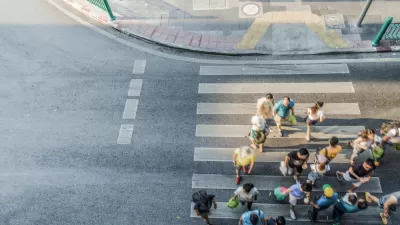Elaine Herzberg's death by autonomous vehicle on March 18 in Tempe was a "first," but what of the 224 pedestrians that died last year in Arizona, the nation's most dangerous state for pedestrians according to a 50-state report released Feb. 28?
Five days before Elaine Herzberg was fatally struck on March 18 by an Uber operating in autonomous mode with a driver behind the wheel in Maricopa County, Az., becoming the first pedestrian fatality caused by a self-driven vehicle, four pedestrians were struck by an SUV that hopped a curb in Fountain Hills, also Maricopa County.
Those three pedestrian deaths and one critical injury was no aberration among 10 pedestrian fatalities in the Phoenix Metro area that week. Arizona had the highest pedestrian fatality rate in the nation last year, based on a report released Feb. 28 by the Governors Highway Safety Association.
"GHSA estimates the number of pedestrians killed in motor vehicle crashes nationwide in 2017 was 5,984, a decrease of one half of one percent — essentially unchanged from 2016," notes the summary of the report [pdf] based on the first six months of data last year.
"The increased rate of pedestrian deaths [1.61 per 100,000 people] in Arizona is nearly double the national average of 0.81 deaths per 100,000 people and translates to 113 people killed from January through June of 2017, the national report said," reported BrieAnna J Frank for The Arizona Republic on March 1. "That's up from 101 during the same time span in 2016."
With just over 7 million residents, the Grand Canyon State is the 14th most populous, yet it ranked #5, behind California, Florida, Texas, and New York in pedestrian deaths during the time period.
"The Governor's Office of Highway Safety in Arizona said [Feb. 28] the total number of pedestrian deaths for 2017 jumped to 224 from the previous year," adds Frank. According to agency director, Alberto Gutier, there were 30 bicyclist deaths in 2017.
"I've seen the consequences and the lack of respect for pedestrians and bicyclists," Gutier said, noting that 26 percent of all traffic fatalities in Arizona last year involved pedestrians or bicyclists.
Arizona was hardly alone in seeing its pedestrian fatality rate increase; 22 other states and the District of Columbia experienced increases, while 20 saw decreases, and seven were stable, according to the report.
Nationwide, pedestrians are faring far worse than motorists in terms of safety, notes the study, written by Richard Retting of Sam Schwartz Consulting.
The number of pedestrian fatalities increased 27 percent from 2007 to 2016, while at the same time, all other traffic deaths decreased by 14 percent.
Alissa Walker, Curbed's urbanism editor, pens a powerful piece on March 22 on the death of Herzberg, hoping it will inspire Arizona cities to prioritize pedestrian safety, not by ticketing jaywalkers but through street design.
The fact that the state is so deadly for walkers is not a coincidence. The same factor that is responsible for Arizona’s high number of pedestrian deaths is the very same reason Uber is testing there—the state prioritizes cars over the lives of pedestrians.
Hat tip to Alissa Walker.
FULL STORY: Pedestrian Traffic Fatalities by State: 2017 Preliminary Data

Maui's Vacation Rental Debate Turns Ugly
Verbal attacks, misinformation campaigns and fistfights plague a high-stakes debate to convert thousands of vacation rentals into long-term housing.

Planetizen Federal Action Tracker
A weekly monitor of how Trump’s orders and actions are impacting planners and planning in America.

In Urban Planning, AI Prompting Could be the New Design Thinking
Creativity has long been key to great urban design. What if we see AI as our new creative partner?

San Francisco Mayor Backtracks on Homelessness Goal
Mayor Dan Lurie ran on a promise to build 1,500 additional shelter beds in the city, complete with supportive services. Now, his office says they are “shifting strategy” to focus on prevention and mental health treatment.

How Trump's HUD Budget Proposal Would Harm Homelessness Response
Experts say the change to the HUD budget would make it more difficult to identify people who are homeless and connect them with services, and to prevent homelessness.

The Vast Potential of the Right-of-Way
One writer argues that the space between two building faces is the most important element of the built environment.
Urban Design for Planners 1: Software Tools
This six-course series explores essential urban design concepts using open source software and equips planners with the tools they need to participate fully in the urban design process.
Planning for Universal Design
Learn the tools for implementing Universal Design in planning regulations.
Gallatin County Department of Planning & Community Development
Heyer Gruel & Associates PA
JM Goldson LLC
Mpact (founded as Rail~Volution)
City of Camden Redevelopment Agency
City of Astoria
Jefferson Parish Government
Camden Redevelopment Agency
City of Claremont



























